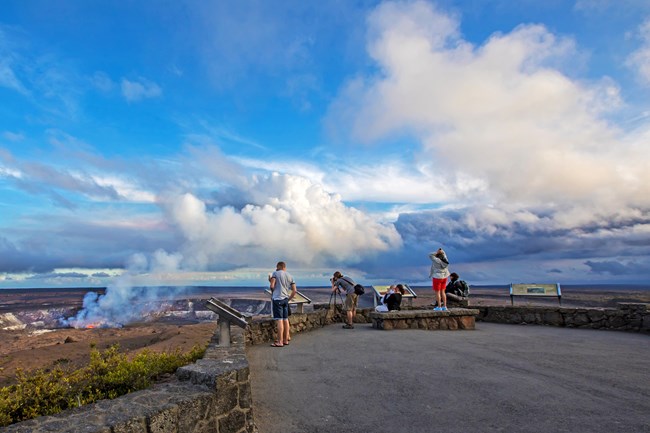
NPS Photo
What is sulfur dioxide?Sulfur dioxide (SO2) is a colorless, reactive air pollutant with a strong odor. This gas can be a threat to human health, animal health, and plant life. How can sulfur dioxide affect your health?Sulfur dioxide irritates the skin and mucous membranes of the eyes, nose, throat, and lungs. High concentrations of SO2 can cause inflammation and irritation of the respiratory system, especially during heavy physical activity. The resulting symptoms can include pain when taking a deep breath, coughing, throat irritation, and breathing difficulties. High concentrations of SO2 can affect lung function, worsen asthma attacks, and worsen existing heart disease in sensitive groups. This gas can also react with other chemicals in the air and change to a small particle that can get into the lungs and cause similar health effects. Who is at risk?People sensitive to sulfur dioxide include:
Hawai'i Volcanoes NP visitors, residents, and park staff downwind of the volcanic SO2 emissions can be exposed to unhealthy levels of pollution. Since it is not possible to control volcanic activity, the National Park Service participates in a sulfur dioxide advisory program, which gives out warnings to let people know when unhealthy levels of this pollutant are present. Advisories encourage people to limit their exposure when necessary. How can I avoid unhealthy exposure?You can take simple steps to reduce your exposure to unhealthy air. First, visit the Current Conditions Website to find out about current sulfur dioxide conditions and the health advisory level. What are the NPS sulfur dioxide health advisories?A SO2 air pollution advisory program was created at Hawai'i Volcanoes NP to deliver timely information about possible unhealthy air pollution conditions that could affect the health of visitors, island residents, and park personnel. Using the Environmental Protection Agency (EPA) air quality index, the NPS SO2 health advisories for Hawai'i Volcanoes NP help you understand what local air quality means to your health. The air quality index is divided into six levels of health concern: 
Understanding Sulfur Dioxide Health Advisory Levels
The SO2 and weather data used in this program are collected by the National Park Service at the Jaggar Museum and Kilauea Visitor Center monitoring sites. The SO2 concentrations measured at the monitoring sites are reviewed every 15 minutes and one of six advisory levels of health concern are assigned for that 15-minute period for each site. How does sulfur dioxide affect national parks?Hawai'i Volcanoes NP is significantly impacted by sulfur dioxide because the high levels create a human health concern. Sulfate particles can also create haze and reduce visibility at Hawai'i Volcanoes NP and other national parks. Sulfur dioxide can convert to acids in the atmosphere and come down from the atmosphere in rain, snow, or fog, or as dry particles. This atmospheric deposition can damage vegetation, affect soils, acidify lakes and streams, and ruin memorials, buildings, and statues at our national cultural monuments. |
Last updated: October 25, 2024
